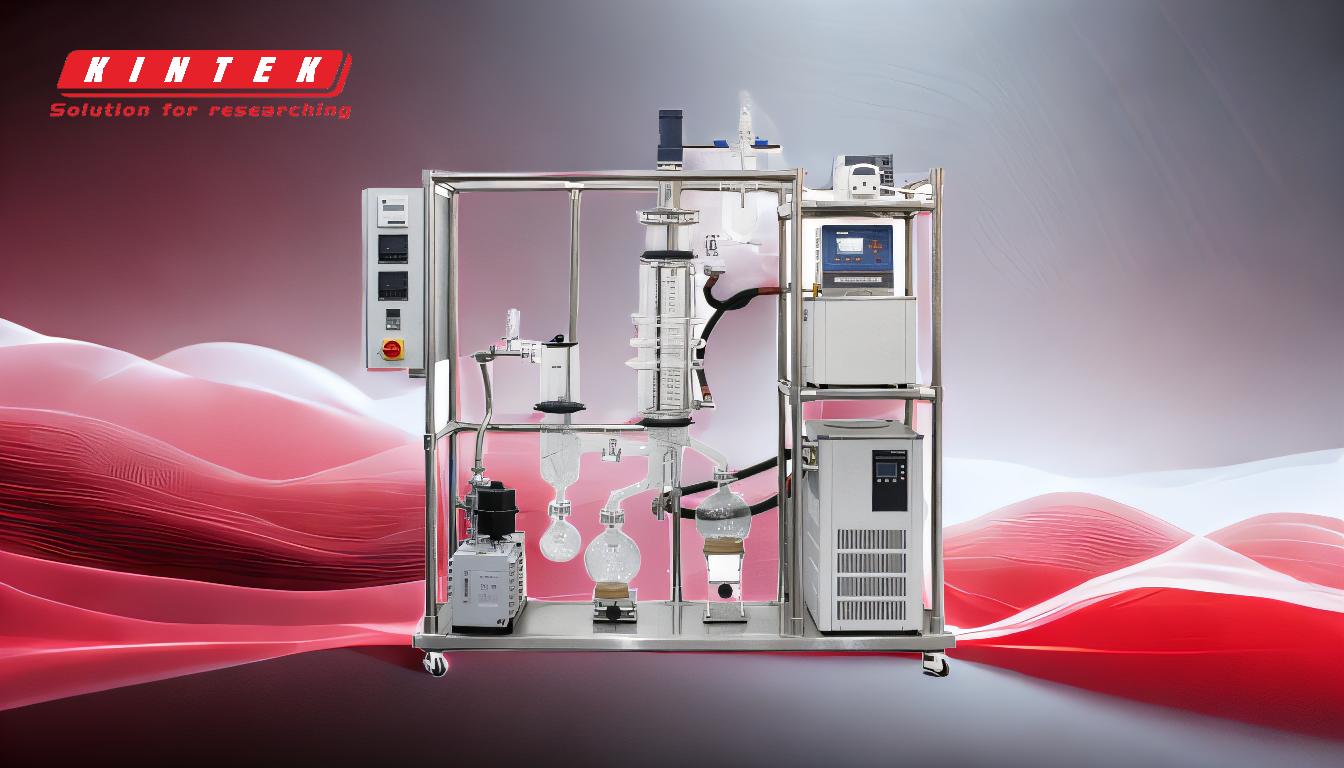Distillation determines purity by exploiting the differences in boiling points of components in a mixture. By heating the mixture, the component with the lower boiling point vaporizes first, leaving behind impurities or other components. The vapor is then cooled and condensed back into a liquid, resulting in a purified substance. This process can be repeated or enhanced with techniques like vacuum distillation or thin-film technology to achieve even higher purity levels. The efficiency of distillation in determining purity depends on factors such as the volatility of the components, the precision of temperature control, and the design of the distillation apparatus.
Key Points Explained:

-
Principle of Distillation:
- Distillation relies on the principle that different components in a mixture have different boiling points.
- When a mixture is heated, the component with the lower boiling point vaporizes first, while the higher boiling point components remain in the liquid phase.
- This separation is based on volatility, which is the tendency of a substance to vaporize.
-
Process of Distillation:
- Heating: The mixture is heated to a temperature where the desired component begins to vaporize.
- Vaporization: The vaporized component rises and is separated from the remaining liquid.
- Condensation: The vapor is then cooled and condensed back into a liquid form, which is collected as the purified substance.
- Collection: The condensed liquid is collected in a separate container, leaving behind impurities or other components.
-
Types of Distillation:
- Simple Distillation: Used for mixtures where the boiling points of the components are significantly different. It is effective for separating liquids with a large difference in boiling points.
- Fractional Distillation: Used for mixtures with closer boiling points. It involves a fractionating column that allows for multiple vaporization-condensation cycles, increasing the separation efficiency.
- Vacuum Distillation: Used for substances that decompose at high temperatures. By reducing the pressure, the boiling point of the substance is lowered, allowing for distillation at lower temperatures.
- Steam Distillation: Used for heat-sensitive compounds, such as essential oils. Steam is passed through the mixture, carrying the volatile components with it.
- Thin-Film Distillation: Enhances the efficiency of distillation by spreading the mixture into a thin layer, allowing for quicker and more effective evaporation of unwanted materials.
-
Determining Purity:
- Temperature Control: The purity of the distilled substance is determined by the precision of temperature control during the heating process. If the temperature is carefully controlled to match the boiling point of the desired component, the resulting distillate will be highly pure.
- Multiple Distillations: Repeated distillation cycles can further increase purity by removing any residual impurities that may have been carried over in the initial distillation.
- Analytical Techniques: After distillation, the purity of the collected substance can be confirmed using analytical techniques such as gas chromatography, mass spectrometry, or refractive index measurement.
-
Applications of Distillation:
- Chemical Laboratories: Distillation is commonly used in labs to purify solvents, separate reaction products, and isolate specific compounds.
- Industrial Processes: In industries, distillation is used to refine crude oil, produce alcoholic beverages, and purify chemicals.
- Pharmaceuticals: Distillation is crucial in the production of pure pharmaceutical compounds, ensuring that medications are free from harmful impurities.
- Food and Beverage Industry: Distillation is used to produce spirits, essential oils, and other food-grade products.
-
Factors Affecting Purity:
- Boiling Point Difference: The greater the difference in boiling points between the components, the easier it is to achieve high purity through distillation.
- Equipment Design: The design of the distillation apparatus, including the type of column, condenser, and collection system, can significantly impact the purity of the final product.
- Operating Conditions: Factors such as pressure, temperature, and flow rate must be carefully controlled to ensure optimal separation and purity.
-
Limitations of Distillation:
- Azeotropes: Some mixtures form azeotropes, where the components have the same boiling point, making separation by distillation impossible.
- Thermal Degradation: Heat-sensitive compounds may degrade during the distillation process, limiting the use of high temperatures.
- Energy Consumption: Distillation can be energy-intensive, especially for large-scale industrial applications.
In summary, distillation is a powerful and widely used method for determining and achieving the purity of substances by leveraging differences in boiling points. The process involves heating, vaporization, condensation, and collection, with various techniques available to enhance efficiency and purity. The purity of the final product depends on factors such as temperature control, equipment design, and the nature of the mixture being distilled.
Summary Table:
| Aspect | Details |
|---|---|
| Principle | Separation based on differences in boiling points. |
| Process | Heating, vaporization, condensation, and collection. |
| Types | Simple, fractional, vacuum, steam, and thin-film distillation. |
| Purity Factors | Temperature control, multiple distillations, and analytical techniques. |
| Applications | Chemical labs, industrial processes, pharmaceuticals, and food production. |
| Limitations | Azeotropes, thermal degradation, and energy consumption. |
Discover how distillation can optimize your processes—contact our experts today for tailored solutions!










